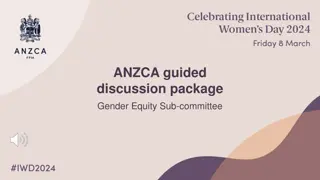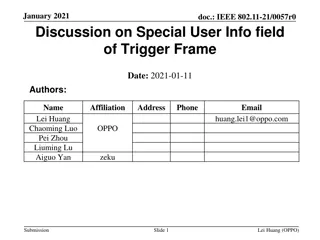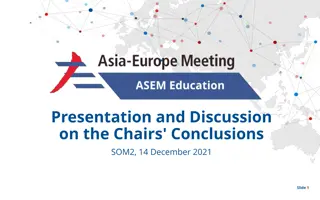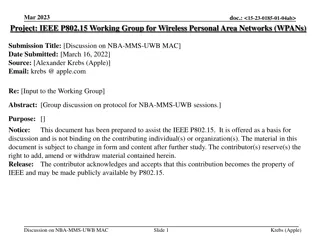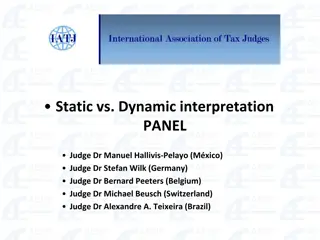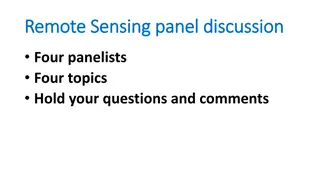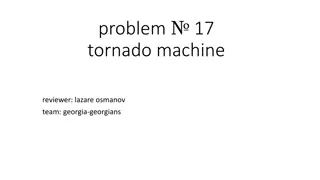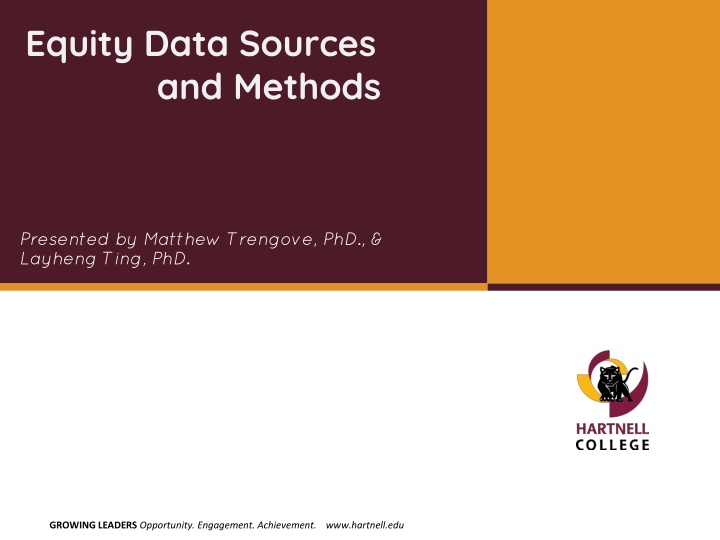
Equity Data Sources and Methods for Disproportionate Impact Analysis
Explore how data sources and methodologies are used to identify disproportionate impact in educational settings. Learn about the 80% Rule, Percentage Point Gap, and Proportionality Index to assess outcomes across different demographic groups. Gain insights from a DI exemplar for the 2015-16 academic year, highlighting awards and enrollment rates for various racial and ethnic groups.
Download Presentation

Please find below an Image/Link to download the presentation.
The content on the website is provided AS IS for your information and personal use only. It may not be sold, licensed, or shared on other websites without obtaining consent from the author. If you encounter any issues during the download, it is possible that the publisher has removed the file from their server.
You are allowed to download the files provided on this website for personal or commercial use, subject to the condition that they are used lawfully. All files are the property of their respective owners.
The content on the website is provided AS IS for your information and personal use only. It may not be sold, licensed, or shared on other websites without obtaining consent from the author.
E N D
Presentation Transcript
Equity Data Sources and Methods Presented by Matthew Trengove, PhD., & Layheng Ting, PhD. GROWING LEADERS Opportunity. Engagement. Achievement. www.hartnell.edu
Introduction Promote a deeper understanding of the data, sources, and methods for calculating disproportionate impact Data: Vision for Success dashboard, DataMart and/or Student Success Metrics Dashboard Methods: enacted by the California Community College Chancellor s Office (CCCCO) and codified through the Hartnell governance process (e.g., Strategic Plan and/or IEF). Institutional Effectiveness Framework (IEF) Metrics are assigned an Aspirational, Attainable & Minimum Expectation target to allow for normal fluctuations in the data to be resolved and/or revealed over time. Minimum expectation (ME): represent minimally acceptable outcome below which extraordinary action (EAC) must be taken.* *Normally taken as a result of a trend of three consecutive years of unacceptable performance. GROWING LEADERS Opportunity. Engagement. Achievement. www.hartnell.edu
Disporportionate Impact (DI) Methodologies The CCCCO uses The 80% Rule to calculate DI among enrollment, retention, success & completion metrics. Does a subgroup achieve the desired outcome less than 80% of the time? 80% index = cohort group rate reference group rate based on the Equal Employment Opportunity Commission (EEOC) 80% Rule in which a selection rate for any race, sex, or ethnic group is less than four-fifths will generally be regarded by Federal enforcement agencies (e.g., Title VII enforcement by the U.S. Equal Opportunity Commission, Department of Labor, and the Department of Justice) as evidence of adverse impact (CCCCO, 2014). Other methods include: The Percentage Point Gap (PPG): Is there a difference in a given demographic group and the observed overall average/mean across all demographic groups? Percentage point gap = % of outcome for students in subgroup % of outcome for all students The Proportionality Index (PI): If a subgroup of students represents 45% of the student body, does that same subgroup also represent at least 45% of the students who achieve the desired outcome? Proportionality index = proportion in outcome group proportion in cohort GROWING LEADERS Opportunity. Engagement. Achievement. www.hartnell.edu
DI Exemplar 2015-16AY Demographic Group Non-Transfer Associates Awards Enrolled 80% Rule 80% Results PI Awards PI Enrolled PI Results American Indian or Alaska Native 2 92 2.17% 99.11% 0.36% 0.36% 99.11% Asian 7 586 1.19% 54.46% 1.27% 2.32% 54.46% Black or African American 8 568 1.41% 64.21% 1.45% 2.25% 64.21% Filipino 19 578 3.29% 149.86% 3.44% 2.29% 149.86% Hispanic or Latino 427 14022 3.05% 138.83% 77.22% 55.62% 138.83% Native Hawaiian or other Pacific Islander 2 108 1.85% 84.43% 0.36% 0.43% 84.43% More than one race 17 368 4.62% 210.60% 3.07% 1.46% 210.60% Some other race 2 2784 0.07% 3.28% 0.36% 11.04% 3.28% White 69 6105 1.13% 51.53% 12.48% 24.22% 51.53% Overall 553 25211 2.19% 100.00% 100.0% 100.0% 100.00% GROWING LEADERS Opportunity. Engagement. Achievement. www.hartnell.edu
DI Exemplar of the 80% Rule 2015-16AY Demographic Group Non-Transfer Associates Awards Enrolled 80% Rule 80% Results PI Awards PI Enrolled PI Results American Indian or Alaska Native 2 92 2.17% 99.11% 0.36% 0.36% 99.11% Asian 7 586 1.19% 54.46% 1.27% 2.32% 54.46% Black or African American 8 568 1.41% 64.21% 1.45% 2.25% 64.21% Filipino 19 578 3.29% 149.86% 3.44% 2.29% 149.86% Hispanic or Latino 427 14022 3.05% 138.83% 77.22% 55.62% 138.83% Native Hawaiian or other Pacific Islander 2 108 1.85% 84.43% 0.36% 0.43% 84.43% More than one race 17 368 4.62% 210.60% 3.07% 1.46% 210.60% Some other race 2 2784 0.07% 3.28% 0.36% 11.04% 3.28% White 69 6105 1.13% 51.53% 12.48% 24.22% 51.53% Overall 553 25211 2.19% 100.00% 100.0% 100.0% 100.00% GROWING LEADERS Opportunity. Engagement. Achievement. www.hartnell.edu
DI Exemplar of the Proportionality Index 2015-16AY Demographic Group Non-Transfer Associates Awards Enrolled 80% Rule 80% Results PI Awards PI Enrolled PI Results American Indian or Alaska Native 2 92 2.17% 99.11% 0.36% 0.36% 99.11% Asian 7 586 1.19% 54.46% 1.27% 2.32% 54.46% Black or African American 8 568 1.41% 64.21% 1.45% 2.25% 64.21% Filipino 19 578 3.29% 149.86% 3.44% 2.29% 149.86% Hispanic or Latino 427 14022 3.05% 138.83% 77.22% 55.62% 138.83% Native Hawaiian or other Pacific Islander 2 108 1.85% 84.43% 0.36% 0.43% 84.43% More than one race 17 368 4.62% 210.60% 3.07% 1.46% 210.60% Some other race 2 2784 0.07% 3.28% 0.36% 11.04% 3.28% White 69 6105 1.13% 51.53% 12.48% 24.22% 51.53% Overall 553 25211 2.19% 100.00% 100.0% 100.0% 100.00% GROWING LEADERS Opportunity. Engagement. Achievement. www.hartnell.edu
DI Methodologies (Advantages Vs Limitations) GROWING LEADERS Opportunity. Engagement. Achievement. www.hartnell.edu
References Methodology: CCCCO (2014) Guidelines for measuring disproportionate impact in equity plans, California Community Colleges Chancellors Office, July 6, 2014 revision, pg 4 Sosa, G., (2018) Using Disproportionate Impact Methods to Identify Equity Gaps, California Community Colleges Chancellors Office, July 2017, Revised February 2018, pg 11 Data Sources: California Community Colleges Chancellor's Office , Data Mart., Retention/Success Rate.: https://datamart.cccco.edu/Outcomes/Course_Ret_Success.aspx California Community Colleges Chancellor's Office , Vision for Success. Accessed from Data on Demand. Student Success Metrics, Cal-PASS Plus: https://www.calpassplus.org/LaunchBoard/Student-Success-Metrics.aspx GROWING LEADERS Opportunity. Engagement. Achievement. www.hartnell.edu





